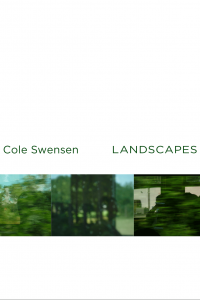Book Review
Just as the grey-green fields out the window in Landscapes on a Train are laced with roads and trails, Cole Swensen’s verbal landscape is crisscrossed with garden path sentences—“Quiet lights the fog, washes the grey,” “White arches cross a river,” “Leaves or is seen receding.” A garden path sentence is a grammatical form that upon first read appears ungrammatical—its meaning and structure disappear as “a road disappears,” depositing the reader at a syntactic dead-end. Psycholinguists often cite garden path sentences when demonstrating the fact that people parse sentences serially—we experience language and make meaning word by word, and this tendency can sometimes lead us astray. To make sense of a garden path sentence, like the ones in Landscapes, one has to stop, go back, and read it over again—looking at “Quiet lights the fog” the second time around, I knew better than to conceive of “Quiet lights” as a modified noun and instead understood it as a noun and a verb. The sentence snapped into sense.
But a train moves always forward. If, through the window, you see “hundreds of swans” or a “burning field” or “miniature horses in three corrals” and you want to see that image again, or for longer, or just to make sure that it was even actually there, you can’t. This is the crucial difference between the passenger’s experience and the reader’s. Readers have the option of taking the same journey twice. When we read we can slow down to parse wending sentences. We can re-read and re-re-read a page whenever and as many times as we please. We can see exactly what we saw the first time again, but slower, or faster, or with more attention to detail.
Landscapes on a Train is a kind of training ground, toward a different way of reading. Swensen, I think, wants us to read more like passengers. She trains us with sentences like these:
“Is not the same nor the same number are seven horses turned to trees.”
“Where a man who walks faster than the trees in the / Grey mist into which the trees recede.”
“A collection of crows to the touch.”
Swensen reveals to us the futility of our normal reading practices. After a few tries it becomes clear that no amount of time or care will smooth out their syntax—to really enter them we must leave our analytical tendencies on the platform. Swensen’s sentences, her lines, are themselves like trains. Reading Landscapes, we are carried forward across the page, and across a swath of French countryside, in vehicles of another’s construction. Taking these phrases and images in, and just as easily letting them give way to the next, as scenes outside a train window continuously give way to new scenes, is an exercise in passengership. And as the views whiz by, the illusion of landscape’s motion, and the passenger’s stasis, fades. As we read, we recognize that in fact we are in motion; the train, the sentences, are moving us.
Swensen’s poems, arranged on the page in windowlike, prose-shaped blocks, do what the best poems do: they carve holes in what would otherwise be opaque walls, mediating for her readers a view into spaces we would otherwise never see. But the work here is not Swensen’s alone; a train with no one onboard is like a tree toppling alone in a forest, or a page lying open, unread. Swensen calls on us, her passengers, to fix our eyes on the window—to look out for the poetry that arises everywhere as we move through the world, like how without any reason or explanation, outside the speaker’s own train window and on the page, “seven horses turned to trees” or “the water walk[s] over the meadow like a line of bare / Poplars walks over a field.”
The clever form that the poems in Landscapes take is indeed another kind of training ground for the reader-passenger, priming us to notice poetic moments where we might not as readily expect to find them. Typically, when we read prose, we are so accustomed to gliding downward and to the left again each time we arrive at the right margin that we hardly notice that movement. In Landscapes, every line is approximately the same length, and so the stanzas look like prose paragraphs. But each line begins with a capital letter. Swensen’s capitals call attention to prose’s dormant (ubiquitous!) enjambments: “River of trees that turns / Its back,” “Even farther / Down,” “Broke / The ruined ruin.” This formal move in Landscapes will hopefully enrich the way that we read on a larger scale. Now perhaps when we open our textbooks and emails and newspapers, we’ll recognize the poetry latent in them too—the serendipitous meaning-bending and -making that happens when a sentence hits the right margin and breaks.
Landscapes endeavors to train its readers to recognize the poetry waiting for us whenever we zoom across a landscape, or down a page—the poetry that we are so practiced at either overanalyzing or ignoring. On page 11 Swensen writes, “A train lands all night across an open field.” This state of constant arrival is what Swensen seems to want for her reader-passengers. She wants us to trust the innate, human impulse to parse the world word by word, image by image—to land all day and all night in the world, and across the open page.
About the Reviewer
Caroline Kanner is an undergraduate at Yale studying cognitive science. One of her poems was recently published in the math textbook Fractal Worlds: Grown, Built, and Imagined.
